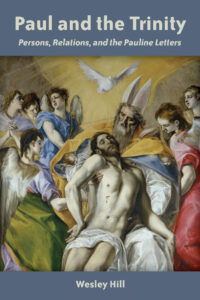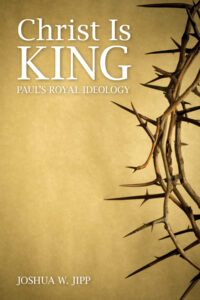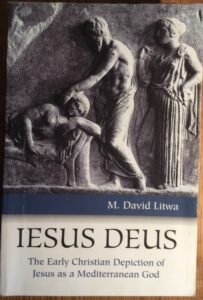 Wesley Hill has written an important book about Paul’s theology, developing the work of his doctoral supervisor Professor Francis Watson (of Durham University, UK), on some ways in which trinitarian theology us understand the shape of Paul’s language about God the Father, Jesus Christ and the Spirit: Paul and the Trinity: Persons, Relations, and the Pauline Letters (Eerdmans, 2015). Sadly I came to it after completing volume 1 of Jesus Monotheism, but I am happy to report that its arguments dovetail with my own understanding of Pauline Christology, and in several ways it makes a timely contribution to the study of NT Christology.
Wesley Hill has written an important book about Paul’s theology, developing the work of his doctoral supervisor Professor Francis Watson (of Durham University, UK), on some ways in which trinitarian theology us understand the shape of Paul’s language about God the Father, Jesus Christ and the Spirit: Paul and the Trinity: Persons, Relations, and the Pauline Letters (Eerdmans, 2015). Sadly I came to it after completing volume 1 of Jesus Monotheism, but I am happy to report that its arguments dovetail with my own understanding of Pauline Christology, and in several ways it makes a timely contribution to the study of NT Christology.
The highlights:
- A clear and readable overview of recent approaches to Trinitarian theology that makes technical discussions among systematicians accessible to NT scholars trained in traditional historical and literary methodologies.
- A compelling discussion of the need to account for all the evidence for the relationship between God the Father and the Lord Jesus Christ through simultaneous descriptions of the ways they are and the ways they are not differentiated from one another—a “redoubled” discourse that does justice to their asymmetrical mutuality.
- One of the clearest and best exposition of 1 Cor 8:6 that I know of.
- Some incisive criticisms of the work of leading voices in NT Christology scholarship (Dunn, James McGrath, Hurtado and Bauckham).
In arguing for a trinitarian reading of Paul Hill provides an astute analysis of mainstream modern scholarship for whom it has been a badge of honour that the interpretation of Paul is not contaminated by anachronistic patristic categories. Reading Paul’s talk about God, Christ and the Spirit in terms of the relations between persons also produces some invaluable exegetical insights. He does a fine job, for example, critiquing the common view that the last phrase in Phil 2:6–11 (“to the glory of God the Father”) is a rear guard action designed to ensure that there is no suggestion of competition between the one God and the exalted Christ.
In one respect, this book will, I hope, change the field forever: Hill calls out and challenges the assumption that it is right to frame discussion of NT Christologies in terms of whether, in a particular passage or at a point on a historical line of development, there is a “low” or “high” Christology (esp. pp. 18–30, 168–9). As he rightly notes, the standard question in twentieth century has been “the degree of Jesus’ divinity” (quoting Raymond Brown). Hill proposes that that the texts should be discussed within a different framework—one that respects the traditional Christian language of divine persons and relations. God the Father, Christ and the Spirit all belong within a web, or skein, of relations, rather than on a vertical axis (p. 169). In this, he makes a cogent case that should help direct the terms of all future discussion NT Christology. I have long had my doubts about the high-low framework and I touched on this issue in Jesus Monotheism, Volume 1 (ch. 3). In the wake of Hill’s book I propose the high-low Christology language should either be abandoned or used with great care and a consciousness of the theological and methodological assumptions that it makes.
Three critical observations:
1. Hill is right to challenge the dominant historical model that insists we must interpret NT theology solely through the categories of Second Temple Judaism (comparing Christ to angelic or divine mediator figures, for example). However, at times the baby is thrown out with the bathwater and Hill abstracts Paul’s letters from their historical context. And this means his trinitarian reading of Phil 2:6–11 is unlikely to convince because he does deal adequately with the historical objections to it. There are weighty reasons for thinking that in that Passage Paul cites a hymn that ascribes to Chirst the language of the divine ruler and ideal emperor, and that the text’s primary context is an early Christian political theology rather than a later trinitarian one. For several specialists, Samuel Vollenweider1 and Adela Yarbro Collins2 among them, that context means the hymn cannot be anachronistically interpreted through fourth century categories. It is surprising that Hill does not engage this political reading of the passage.
A robust engagement with Paul’s historical context should not be feared. Hill argues it is a mistake to read the last phrase of Phil 2:11c—“to the glory of God the Father”—and hear a concession to Jewish monotheism that ensures Christ and God the Father are not in competition with each other. I agree with him on this point. (There is no reason to think that among the earliest Christians anyone would think that the rest of Phil 2:6–11 would suggest competition between God (the Father) and the Lord Jesus Christ. That explanation of v. 11c tells us far more about modern notions of Jewish and early Christian theology than it actually reflects first century views or debates). But I am surprised that Hill does not comment on the Philippians context of the hymn. That might help his case. Is it a coincidence that Paul is bothered by a competitive culture of honour and glory in Roman Philippi (on which see Joseph Hellerman, Reconstructing Honor in Roman Philippi: Carmen Christi as Cursus Podorum, 2005), and that the hymn supports his call for a unity of relations among his readers (Phil 1:27–2:4, cf. 4:2)? In the surrounding literary context “glory” and “vainglory” (i.e. competition for honour and glory) are concerns at the forefront of Paul’s argument (1:11; 2:4; 3:18–21; cf. 4:1). In this context, I suggest, the hymn presents a harmonious relationship between divine persons as a model or warrant for harmonious relations between human persons. The usual scholarly view (that Hill rejects) concedes the point to those who fear a competition for honour and glory between God the Father and the exalted Christ. That usual view, in effect, implicitly endorses the (cultural and philosophical) assumptions in pagan Philippi: persons, including divine ones, compete for honour and glory.
2. A danger in reading Paul through the lens of later Trinitarian theology is the likelihood that the particularities of individual texts will be ignored. This, I think, has happened in one detail of Hill’s exegesis of Phil 2:6–11. He says our interpretation should recognise the asymmetrical relationship between the divine persons in that God sends Jesus (p. 81, 109). But he doesn’t, does he. And that is one of the ways Phil 2:6–11 is such a remarkable passage: the one “being in the form of God” comes from pre-existence of his own volition (v. 7) and in light of his discerning correctly on the issue of equality with God (v. 6b–c). He is not sent. He is his own person, even in pre-existence. Hill seems to have collapsed Phil 2:6–7 into other incarnational statements in Paul’s letters (e.g. Rom 8:3; Gal 4:4).
3. I agree with N. T. Wright’s (appreciative and constructive) critique of Hill’s book when Wright complains that Hill has ignored all the ways in which the biblical story and theology (especially Adam as God’s image, the Temple, and the Exodus story) provided raw materials and categories for Paul’s presentation of the relationship between God and Christ. What we need now, in the light of the work of both Wright, Hill and others, is a creative conversation between a robustly historical approach to Paul’s (implicitly) trinitarian theology and the later (patristic) construal of that theology in terms of persons and relations.
Such a conversation would no doubt mean that the early interpreters of Paul will sometimes illuminate his writings. But it will also lead us to conclude, I am sure, that, in some ways, the apostle was closer to the inner meaning and full ramifications of the Christ event and its biblical context than were those who established a trinitarian orthodoxy in the fourth century and beyond. In the end, the question is not who best helps us understand a (Pauline or some other) text (exegesis), but who, or what, most faithfully represents and interprets the life death and resurrection of Jesus (history).
Notes
1. S. Vollenweider, “Der ‘Raub’ der Gottgleichheit: Ein religionsgeschichtlicher Vorschlag zu Phil 2.6(-11).” New Testament Studies 45 (1999): 413–33.
2. A. Y. Collins in A. Y. Collins and J. J. Collins, King and Messiah as Son of God: Divine, Human, and Angelic Messianic Figures in Biblical and Related Literature (Grand Rapids: Eerdmans, 2008), pp. 113–116, 208–9.


